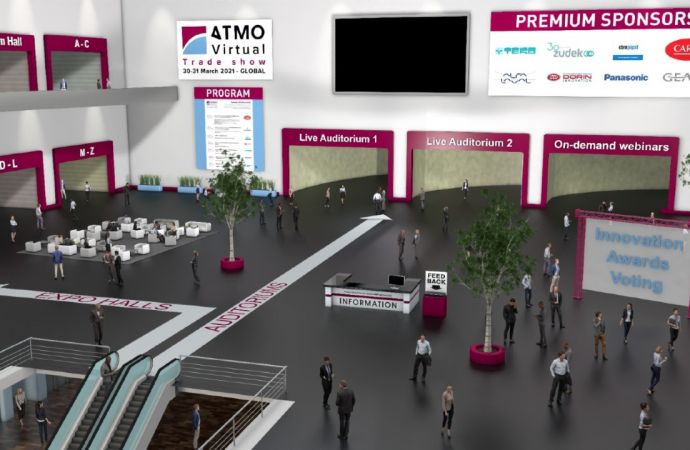The first day of the international conference on natural refrigerants held in Brussels included two sessions about the potential of ammonia as a refrigerant. Industry experts from Star Refrigeration, Nestlé and Mayekawa presented their point of view as well as practical examples that are summarised in the first part of our Atmosphere article series. Presentations now available.

Andy Pearson from Star Refrigeration moderated the dedicated workshop session on ammonia at the Atmosphere 2009 conference that had the overall goal to find solutions to bring natural refrigerants faster to market. Having this in mind the speakers concentrated on presenting real life experience and new technologies that could facilitate the marketing of ammonia as well as recommendations to make the use of ammonia more attractive to industry.
The first part will summarise the first three presentations, followed by part two tomorrow where the second session with presentations from eurammon, Johnson Controls and IIAR will be discussed in more detail.
Andy Pearson, Star Refrigeration: Using Ammonia Effectively
In order to use ammonia effectively Pearson gave same insights on how to overcome the obstacles and how to maximise the benefits of ammonia. The strategy for success would mainly depend on design improvements as well as a more favourable legislative framework.
Pearson mentioned the toxicity of ammonia that is still considered as one of the main problems even though the toxic effect is related to the concentration of ammonia combined with the length of time the exposure lasts. He suggested that the rules for the use of ammonia would need to be simplified to avoid accidents that only occur when rules are not followed. To overcome the flammability hurdle he recommended a legislative framework that uses not only two classes of flammability but three, which would be non-flammable, mildly flammable, and highly flammable.
The conclusions Pearson could draw from many years of experience were that ammonia is safe if used correctly. In addition, it would not only be easy to use and reliable in operation but would also offer an exceptionally good efficiency. As the two key drivers for increased adoption Pearson stated reduced charge systems and enlightened regulation.
Paul Homsy, Nestlé: End User Experience with Ammonia and R744
The Head of Refrigeration & Hygienic Air Handling from Nestlé presented various examples of installations using ammonia, hydrocarbons and R744 worldwide emphasising Nestlé’s priority for natural refrigerants. Different CO2 / NH3 cascade systems in Japan, Moscow and the Czech Republic, as well as the real life examples of an ammonia chiller in Nigeria, an ammonia chilled water plant in Indonesia, and other ones in Vietnam and Shanghai demonstrated the worldwide application of ammonia systems.
To convince more companies to follow the example of Nestle, Homsy called for a code of good practice and consistent development of know-how. He experienced that not all aspects are covered in the legislation regarding the safety of ammonia. As examples he mentioned the way the equipment is arranged, installed, operated and maintained. Safe components not properly installed or maintained would lead to unsafe situations.
Nick Kawamura, Mayekawa: Global Solutions for Ammonia Industrial Refrigeration
In the last presentation of the first ammonia session Kawamura presented lineups and results of Mayekawa’s natural refrigerants. He mentioned that NH3 installations in the industrial refrigeration field in Japan rose significantly from less than 2% in the 1990s to over 80% in 2008. Mayekawa’s strong commitment to the “natural five” refrigerants includes the development of ammonia semi-hermetic screw compressor units for less leakage and higher efficiency. He also gave several examples of operating systems such as heat pump packages using ammonia scroll compressors or ammonia compressors with highly efficient IPM motors.
Kawamura concluded that HFCs can be eliminated in industrial refrigeration applications by using natural refrigerants, such as ammonia. He finally recommended a tightening of regulations of HFCs and the encouragement of funding for the prevalence of refrigeration systems using natural refrigerants as well as the related development.
The first part will summarise the first three presentations, followed by part two tomorrow where the second session with presentations from eurammon, Johnson Controls and IIAR will be discussed in more detail.
Andy Pearson, Star Refrigeration: Using Ammonia Effectively
In order to use ammonia effectively Pearson gave same insights on how to overcome the obstacles and how to maximise the benefits of ammonia. The strategy for success would mainly depend on design improvements as well as a more favourable legislative framework.
Pearson mentioned the toxicity of ammonia that is still considered as one of the main problems even though the toxic effect is related to the concentration of ammonia combined with the length of time the exposure lasts. He suggested that the rules for the use of ammonia would need to be simplified to avoid accidents that only occur when rules are not followed. To overcome the flammability hurdle he recommended a legislative framework that uses not only two classes of flammability but three, which would be non-flammable, mildly flammable, and highly flammable.
The conclusions Pearson could draw from many years of experience were that ammonia is safe if used correctly. In addition, it would not only be easy to use and reliable in operation but would also offer an exceptionally good efficiency. As the two key drivers for increased adoption Pearson stated reduced charge systems and enlightened regulation.
Paul Homsy, Nestlé: End User Experience with Ammonia and R744
The Head of Refrigeration & Hygienic Air Handling from Nestlé presented various examples of installations using ammonia, hydrocarbons and R744 worldwide emphasising Nestlé’s priority for natural refrigerants. Different CO2 / NH3 cascade systems in Japan, Moscow and the Czech Republic, as well as the real life examples of an ammonia chiller in Nigeria, an ammonia chilled water plant in Indonesia, and other ones in Vietnam and Shanghai demonstrated the worldwide application of ammonia systems.
To convince more companies to follow the example of Nestle, Homsy called for a code of good practice and consistent development of know-how. He experienced that not all aspects are covered in the legislation regarding the safety of ammonia. As examples he mentioned the way the equipment is arranged, installed, operated and maintained. Safe components not properly installed or maintained would lead to unsafe situations.
Nick Kawamura, Mayekawa: Global Solutions for Ammonia Industrial Refrigeration
In the last presentation of the first ammonia session Kawamura presented lineups and results of Mayekawa’s natural refrigerants. He mentioned that NH3 installations in the industrial refrigeration field in Japan rose significantly from less than 2% in the 1990s to over 80% in 2008. Mayekawa’s strong commitment to the “natural five” refrigerants includes the development of ammonia semi-hermetic screw compressor units for less leakage and higher efficiency. He also gave several examples of operating systems such as heat pump packages using ammonia scroll compressors or ammonia compressors with highly efficient IPM motors.
Kawamura concluded that HFCs can be eliminated in industrial refrigeration applications by using natural refrigerants, such as ammonia. He finally recommended a tightening of regulations of HFCs and the encouragement of funding for the prevalence of refrigeration systems using natural refrigerants as well as the related development.
MORE INFORMATION
Related stories











